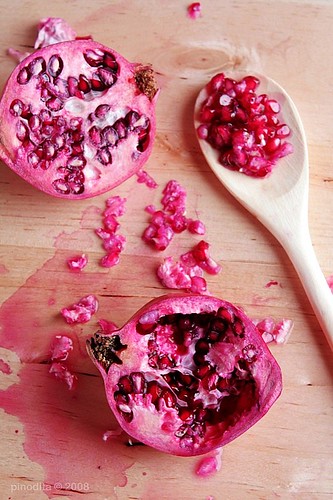

Canon EOS 350 D, lens 50 mm f/1.8, natural daylight
The pomegranate is a popular exotic fruit whose origins are from the Middle East and Asia. Also known as the granada, grenade, and the Chinese apple, pomegranates are now commonly grown in Africa, India, Malaysia, southern Europe, and in the United States, in Arizona and California. Pomegranates typically thrive well when grown in regions where the temperature is mild and where there is little humidity.
Pomegranates are the fruits that are produced from the pomegranate tree, which is a tree that can grow to heights of up to 25 feet. Pomegranate trees live for many years and produce many fruits. The pomegranate tree is also an attractive tree that bears white and red flowers. Once a pomegranate tree is planted, its fruit begins to develop after approximately one year.
You can recognize a pomegranate by its round shape, hard yellow and red colored outer skin, and by its unusual interior flesh that contains many small edible seeds. A semi-sweet pulp that can also be eaten surrounds each of these interior seeds. Additionally, both the seeds and pulp are embedded in a clear membrane. This membrane, although it is also edible, is not very flavorful and is typically not eaten.
Even though this fruit does not originate from China, one common nickname is "Chinese apple."

Culinary Use
After opening the pomegranate by scoring it with a knife and breaking it open, the arils (seed casings) are separated from the skin (peel) and internal white supporting structures (pith and carpellary membrane). Separating the red arils can be simplified by performing this task in a bowl of water, whereby the arils will sink and the white structures will float to the top. The entire seed is consumed raw, though the fleshy outer portion of the seed is the part that is desired. The taste differs depending on the variety of pomegranate and its ripeness. It can be very sweet or it can be very sour or tangy, but most fruits lie somewhere in between, which is the characteristic taste, laced with notes of its tannin.
Pomegranate juice is a popular drink in the Middle East, and is also used in Iranian and Indian cuisine; it began to be widely marketed in the United States in 2002. Fresh pomegranate arils are used in preparation of curd rice (Telugu: Dadhojanam) in Andhra Pradesh in India. Pomegranate concentrate is used in Syrian cuisine. Grenadine syrup is thickened and sweetened pomegranate juice; it is used in cocktail mixing. Before the tomato arrived in the Middle East, grenadine was widely used in many Persian foods; it can still be found in traditional recipes such as fesenjan (a thick sauce made from pomegranate juice and ground walnuts, usually spooned over duck or other poultry and rice) and ash-e anar (pomegranate soup).
Wild pomegranate seeds are sometimes used as a spice, known as anardana (which literally means pomegranate (anar) seeds (dana) in Persian), most notably in Indian and Pakistani cuisine but also as a replacement for pomegranate syrup in Persian and Middle Eastern cuisine. As a result of this, the dried whole seeds can often be obtained in ethnic markets. The seeds are separated from the flesh, dried for 10–15 days and used as an acidic agent for chutney and curry production. The seeds may also be ground in order to avoid seeds becoming stuck in the teeth when eating dishes prepared with them. The seeds of the wild pomegranate daru from the Himalayas are considered the highest quality source for this spice.
In Armenia and the Caucasus, pomegranate (Armenian: nur) is used in a variety of ways, notably as pomegranate juice. In Turkey pomegranate sauce, (Turkish: nar ekşisi) is used as a salad dressing, to marinate meat, or simply to drink straight. Pomegranate seeds are also used in salads and sometimes to garnish desserts such as Güllaç. Pomegranate syrup or molasses are used in Muhammara, a Roasted Red Pepper, Walnut, and Garlic Spread popular in Syria as well as Turkey. In Azerbaijan and Armenia, pomegranate is also used to make high-quality wine which is successfully exported to other countries.
In Greece, pomegranate (Greek: ροδι, rodi) is used in many recipes; such as kollivozoumi, a creamy broth made from boiled wheat, pomegranates and raisins; legume salad with wheat and pomegranate; traditional Middle Eastern lamb kebabs with pomegranate glaze; pomegranate eggplant relish; avocado and pomegranate dip; are just some of the dishes in which it is used. Pomegranate is also made into a liqueur and popular fruit confectionery that can be used as ice cream topping, or mixed with yogurt, and even spread as jams over toast for breakfast.In Cyprus ροδι is used to make kolliva which is wheat, pomegranate and sugar along with almonds and other seeds (offered after someone has died and people do an eulogy in church on the deaths anniversary).
Pomegranates are also used as decorative items. For example, many people purchase pomegranates to place in a fruit bowl as an ornament and accompaniment to other more traditional fruits. This is because pomegranates have an attractive shape and shiny outer skin. The pomegranate is a unique and versatile fruit that can be used in a variety of ways.
Soure :
Wikipedia
http://www.essortment.com/all/whatisapomegr_rldm.htm

No comments:
Post a Comment
thanks for dropping by :)